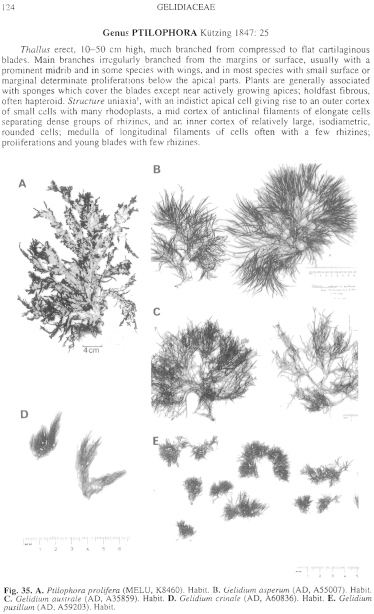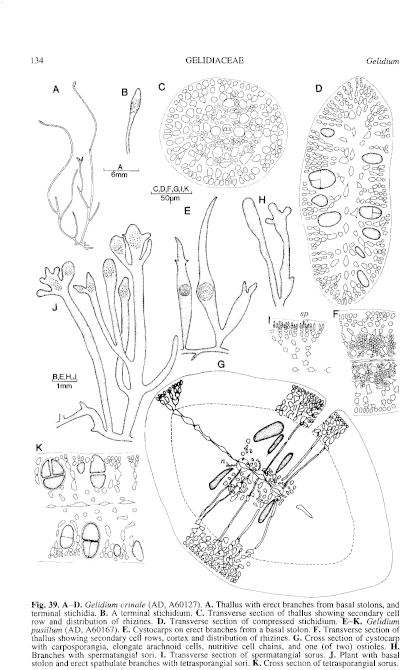|
|
|
|
|
|||||||||||
|
Electronic Flora of South Australia Species Fact Sheet
Phylum Rhodophyta – Class Florideophyceae – Order Gelidiales – Family Gelidiaceae
Selected citations: Feldmann & Hamel 1936: 116, fig. 22, pl. 1 fig. 1.
Synonyms
Fucus crinalis Turner 1819: pl. 198.
G. corneum var. crinalis Greville 1830: 145. Harvey 1846: pl. 53, fig. 5.
Thallus (Figs 35D, 39A) dark red-brown, forming dense turfs or masses 1–2 (–3) cm high and 1–3 cm in spread, with basal stolons, usually short and much branched, bearing erect, slender branches; stolons terete, 100–200 µm in diameter. Erect branches (Fig. 39A) numerous, terete to slightly compressed, of similar dimensions throughout, 100–200 (–300) µm in diameter apart from narrower regenerating branches (after grazing?), rather distantly and irregularly branched usually at intervals of 3–10 (–15) mm; branch tips tapering fairly abruptly to a point, with a clear apical cell when active. Holdfast of clumped rhizoids from the lower side of stolons, 100–300 µm across; epilithic. Structure (Fig. 39C). Outer cortical cells rounded in surface view, protoplast 4–8 (–10) µm across, wall relatively thin, cortex 3–4 cells thick, medulla 3–6 cells across; rhizines throughout medulla in younger branches, in outer medulla in older branches.
Reproduction: In Australia sexual plants only known in culture (see below). Cystocarps subterminal in clustered branchlets, 500–600 µm across (Feldmann & Hamel 1936, p. 118, fig. 22B).
Stichidia (Fig. 39B) terminal on erect branches or on short laterals near the branch apices, occasionally furcate, slightly to distinctly compressed, 0.5–1.5 (–2) mm long, 200–400 (–500) µm broad, occasionally with small lateral lobes; in some specimens the branch has continued growth and the stichidium becomes intercalary. Tetrasporangia (Fig. 39D) of varying ages in mixed sori, all around the stichidia, derived from inner cortical cells, ovoid, 20–30 (–35) µm in diameter, decussately cruciately divided.
Type from England (see Dixon & Irvine 1977a, p. 140); lectotype in BM (ex K).
Selected specimens: Sarge Bay, Cape Leeuwin, W. Aust., upper sublittoral on granite (Gordon, 16.xi.1968; AD, A34207). Kellidie Bay, Coffin Bay, S. Aust., 1–2 m deep (Womersley, 5.xii.1975; AD, A46786). West Bay, Kangaroo I., S. Aust., mid eulittoral (Womersley, 6.i.1945; AD, A9456). Vivonne Bay, Kangaroo I., S. Aust., lower eulittoral, sandy, N side Ellen Point (Womersley, 4.i.1990; AD, A60127-"Marine Algae of southern Australia" No. 345). Pennington Bay, Kangaroo I., S. Aust., in upper eulittoral pools on terraced reef (Womersley, 16.i.1945; AD, A2457 and 20.xii.1990; AD, A60836). Robe, S. Aust., mid eulittoral in bay (Guiry, 4.vii.1988; AD, A58710). Cape Bridgewater, Vic., in high-level pool at "The Blowholes" (Womersley, 21.viii.1953; AD, A19066). Point Lonsdale, Vic., in mid eulittoral pools (Womersley, 23.v.1988; AD, A58692).
Distribution: British Isles, Europe, and probably widespread in temperate regions. In southern Australia, from Cape Leeuwin, W. Aust., to Point Lonsdale, Vic.
Taxonomic notes: G. crinale forms dense turfs where covered by frequent wave-wash or in pools, on coasts of moderate to strong wave action and often subject to sandy conditions.
Tetraspores from plants collected at Point Lonsdale gave rise in culture to dioecious gametangial plants. Female plants formed cystocarps which released carpospores that gave rise to further tetrasporangial plants, thus demonstrating a triphasic life history for G. crinale in Australia (Guiry, unpubl. obs.).
The above specimens agree well with Turner's original description and illustrations. Dixon & Irvine (1977b, p. 126) regarded G. crinale as a form of G. pusillum, but the type of G. crinale and the Australian specimens appear to be distinct from the type of G. pusillum. The Australian specimens agree well with descriptions of plants from the Hawaiian Islands (Santelices 1977, p. 67, fig. 2) and from China (Santelices 1988, p. 96, fig. 5).
References:
DIXON, P.S. & IRVINE, L.M. (1977a). Miscellaneous notes on algal taxonomy and nomenclature IV. Bot. Notiser 130, 137–141.
DIXON, P.S. & IRVINE, L.M. (1977b). Seaweeds of the British Isles. Vol. 1, Rhodophyta. Part I, Introduction, Nemaliales, Gigartinales. [British Museum (N.H.): London.]
FELDMANN, J. & HAMEL, G. (1936). Floridées de France VII. Gélidiales. Rev. Alg. 9, 85–140, Plates 2–6.
GREVILLE, R.K. (1830). Algae Britannicae. (Maclachlan & Stewart: Edinburgh.)
HARVEY, W.H. (1846). Phycologia Britannica. Plates 1–72. (Reeve: London.)
LAMOUROUX, J.V.F. (1825). Gelidie. In Bory de St-Vincent, J.B., Dictionnaire classique d'Hist. nat. Vol. 7, pp. 190–191. (Rey & Gravier: Paris.)
SANTELICES, B. (1977). A taxonomic review of Hawaiian Gélidiales (Rhodophyta). Pacif. Sci. 31, 61–84.
SANTELICES, B. (1988). Taxonomic studies on Chinese Gélidiales (Rhodophyta). In Abbott, I.A. (Ed.), Taxonomy of Economic Seaweeds. With reference to some Pacific and Caribbean species. Vol. II, pp. 91–107. (Calif. Sea Grant College Program: La Jolla, Calif.)
TURNER, D. (1819). Fuci sive Plantarum Fucorum Generi a Botanicis Ascriptarum Icones Descriptiones et Historia. Vol. 4, pp. 1–153, Plates 197–258. (London.)
The Marine Benthic Flora of Southern Australia Part IIIA complete list of references.
Publication:
Womersley, H.B.S. (14 January, 1994)
The Marine Benthic Flora of Southern Australia
Rhodophyta. Part IIIA, Bangiophyceae and Florideophyceae (to Gigartinales)
Reproduced with permission from The Marine Benthic Flora of Southern Australia Part IIIA 1994, by H.B.S. Womersley. Australian Biological Resources Study, Canberra. Copyright Commonwealth of Australia.
Illustrations in Womersley Part IIIA, 1994: FIGS 35D, 39 A–D.

Figure 35 enlarge
Fig. 35. A. Ptilophora prolifera (MELU, K8460). Habit. B. Gelidium asperum (AD, A55007). Habit. C. Gelidium australe (AD, A35859). Habit. D. Gelidium crinale (AD, A60836). Habit. E. Gelidium pusillum (AD, A59203). Habit.

Figure 39 enlarge
Fig. 39. A–D. Gelidium crinale (AD, A60127). A. Thallus with erect branches from basal stolons, and terminal stichidia. B. A terminal stichidium. C. Transverse section of thallus showing secondary cell row and distribution of rhizines. D. Transverse section of compressed stichidium. E–K. Gelidium pusillum (AD, A60167). E. Cystocarps on erect branches from a basal stolon. F. Transverse section of thallus showing secondary cell rows, cortex and distribution of rhizines. G. Cross section of cystocarp with carposporangia, elongate arachnoid cells, nutritive cell chains, and one (of two) ostioles. H. Branches with spermatangial sori. I. Transverse section of spermatangial sorus. J. Plant with basal stolon and erect spathulate branches with tetrasporangial sori. K. Cross section of tetrasporangial sorus.

|
Email Contact: State Herbarium of South Australia |

|